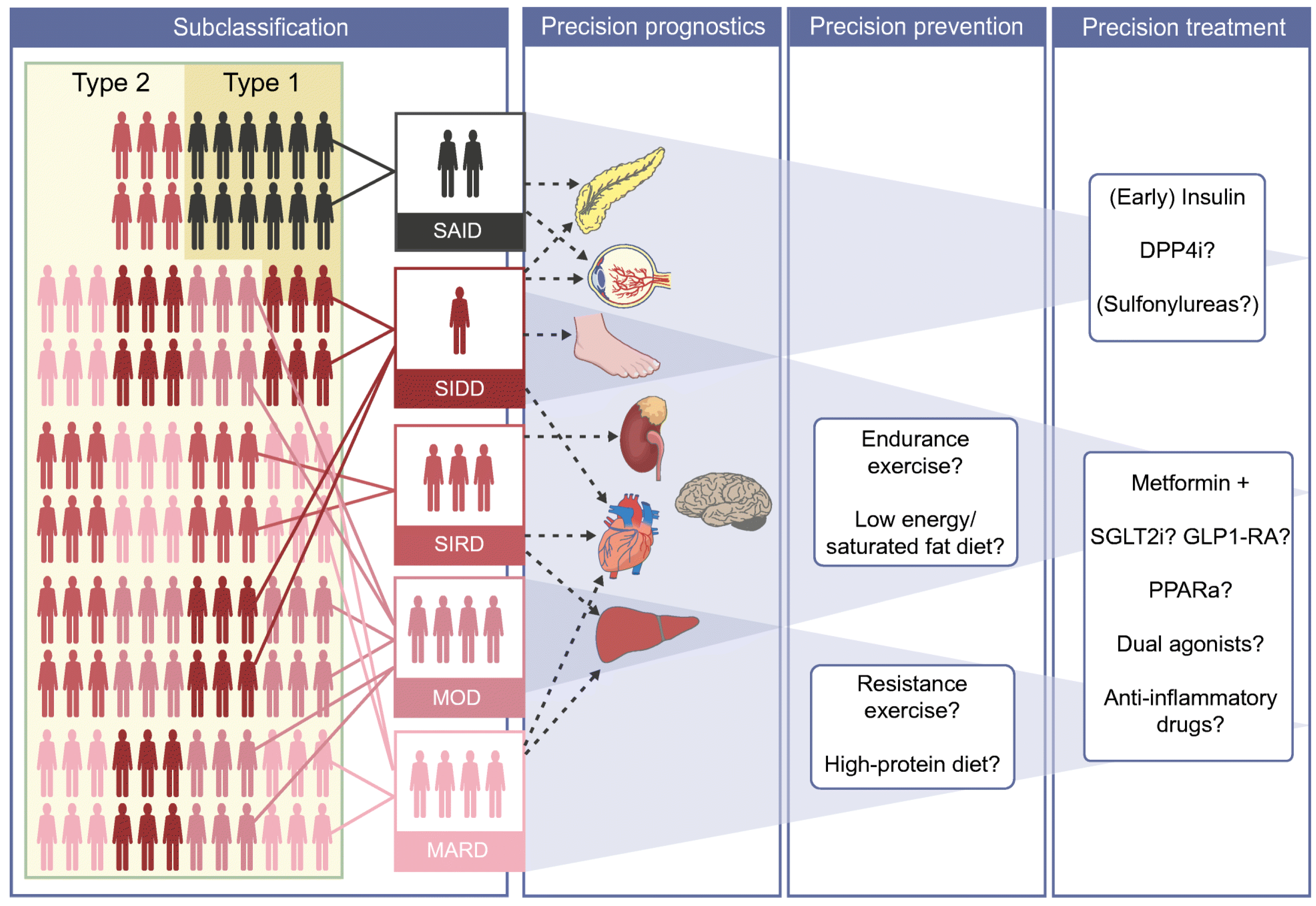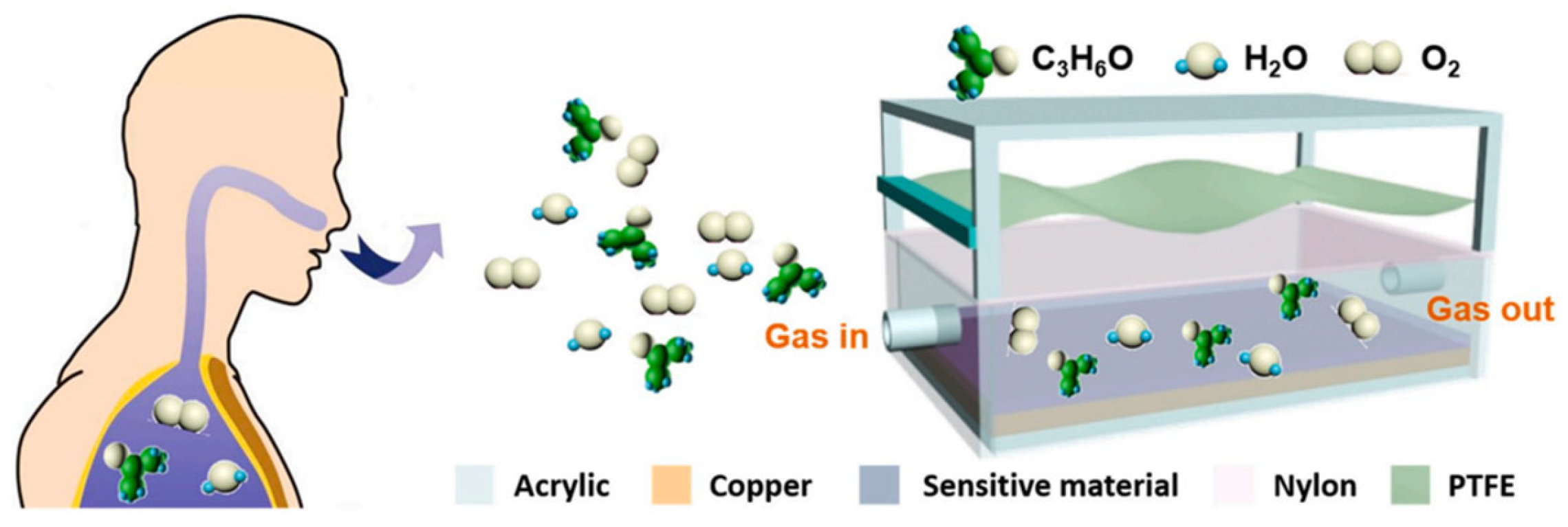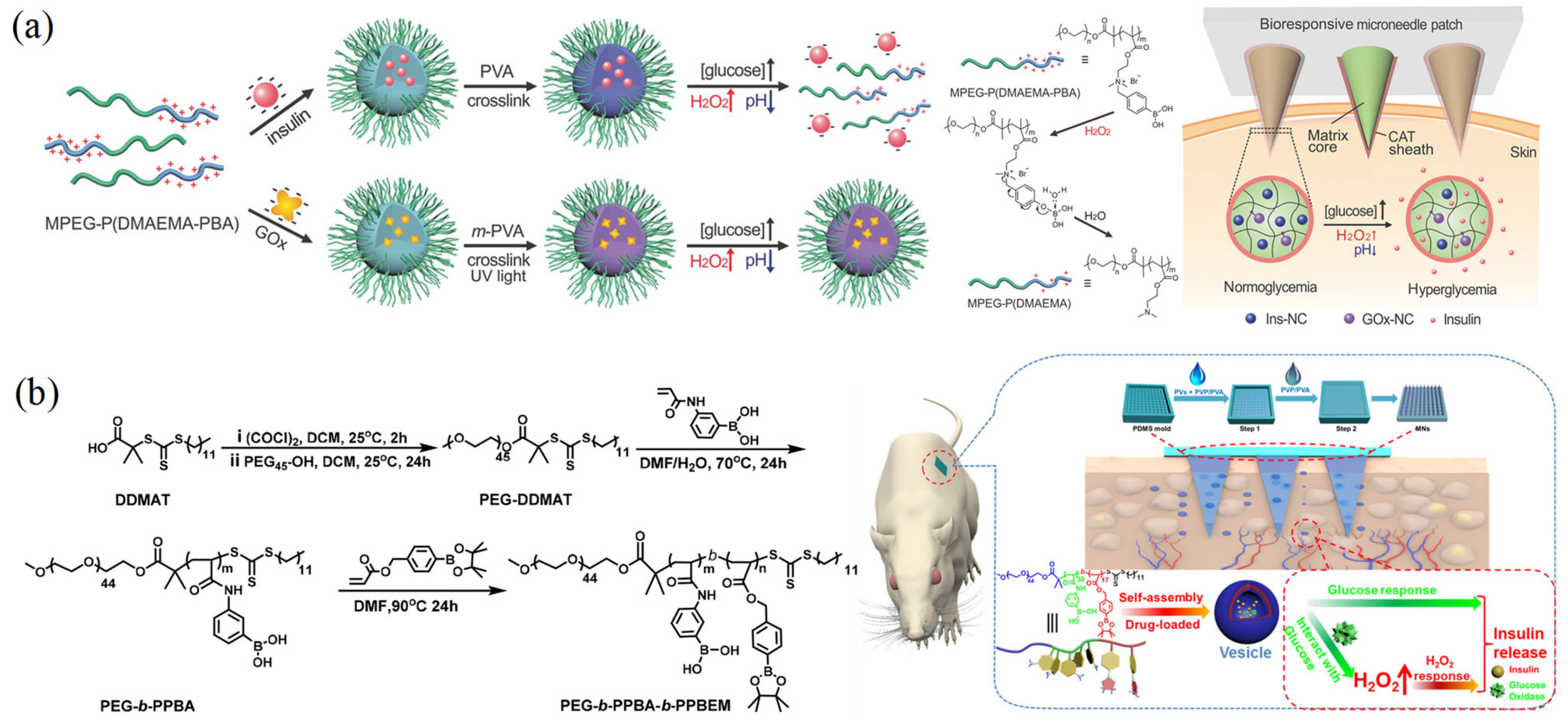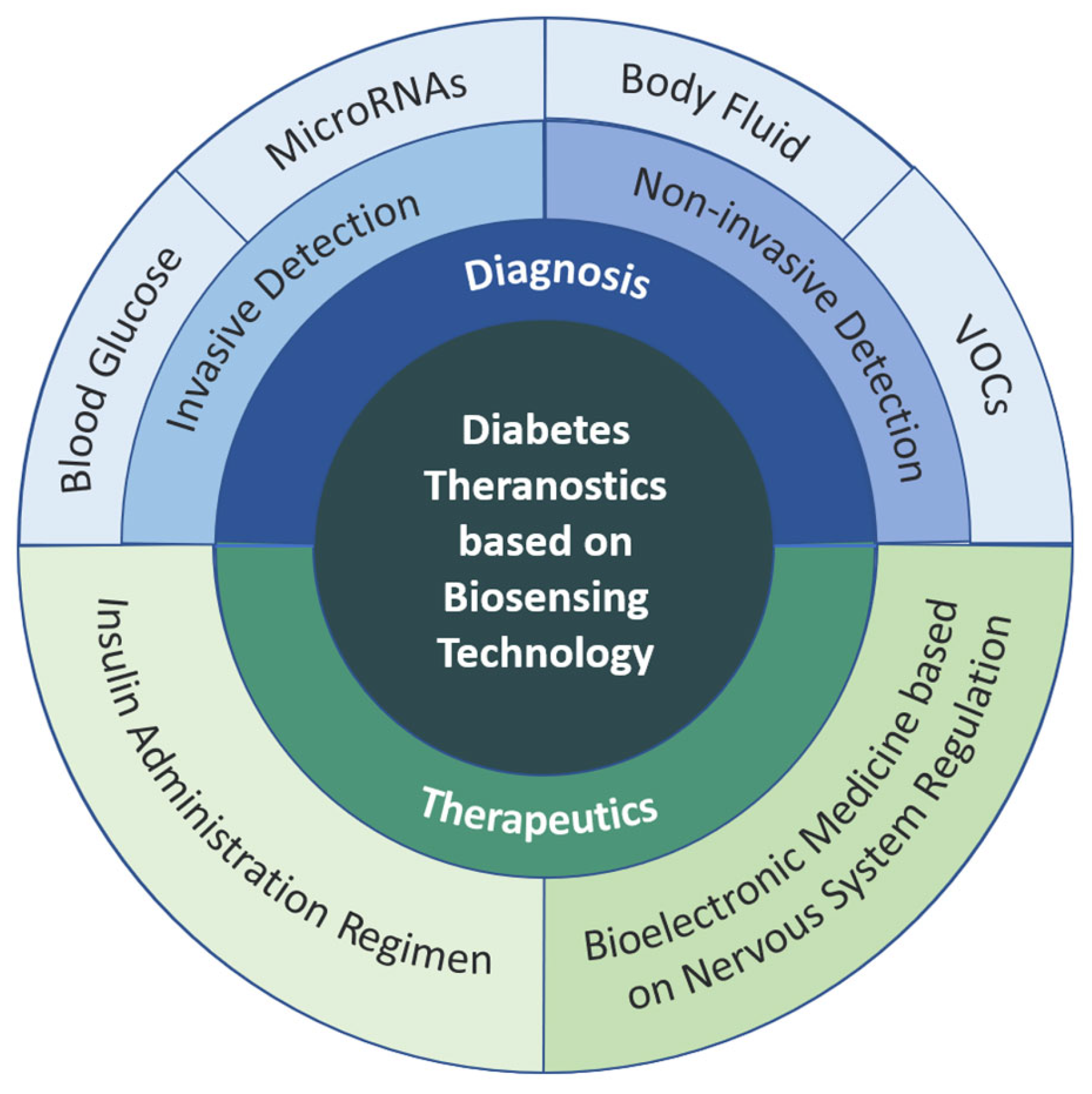Current Status and Prospect of Diabetes Diagnosis and Treatment Based on Biosensing Technology
Abstract
:1. A General Overview of Diabetes Mellitus
1.1. Types and Pathogenesis of Diabetes Mellitus
1.2. Development Status of Diabetes Mellitus Worldwide
1.3. Importance of Diabetes Mellitus Diagnosis and Treatment
2. Diagnosis of Diabetes Based on Electrochemical Biosensing Technology
2.1. Diverse Blood Glucose Detection
2.2. Diverse Selections of Biomarkers for Diabetes
3. Novel Treatment of Diabetes Based on Electrochemical Biosensing Technology
3.1. Insulin Administration Regimen
3.2. Bioelectronic Medicine Based on Nervous System Regulation
4. Summary and Prospect
4.1. Diagnosis of Diabetes
4.2. Treatment of Diabetes
Funding
Institutional Review Board Statement
Informed Consent Statement
Data Availability Statement
Conflicts of Interest
References
- Leslie, R.D.; Palmer, J.; Schloot, N.C.; Lernmark, A. Diabetes at the crossroads: Relevance of disease classification to pathophysiology and treatment. Diabetologia 2016, 59, 13–20. [Google Scholar] [CrossRef] [PubMed] [Green Version]
- Adler, A.; Bennett, P.; Chair, S.C.; Gregg, E.; Narayan, K.M.V.; Schmidt, M.I.; Sobngwi, E.; Tajima, N.; Tandon, N.; Unwin, N.; et al. Reprint of: Classification of diabetes mellitus. Diabetes Res. Clin. Pract. 2021, 108972. [Google Scholar] [CrossRef] [PubMed]
- Burahmah, J.; Zheng, D.; Leslie, R.D. Adult-onset type 1 diabetes: A changing perspective. Eur. J. Intern. Med. 2022, 104, 7–12. [Google Scholar] [CrossRef] [PubMed]
- Zhang, L.W.; Ruan, M.H.; Liu, J.L.; He, C.H.; Yu, J.R. Progress on research and development in diabetes mellitus. Yi Chuan = Hered. 2022, 44, 824–839. [Google Scholar]
- Bezen, D.; Vurgun, E.; Dursun, H. Evaluation of urinary haptoglobin level as a biomarker of diabetic nephropathy in children with type 1 diabetes. Pediatr. Nephrol. 2023. [Google Scholar] [CrossRef]
- Bhatty, A.; Baig, S.; Fawwad, A.; Rubab, Z.E.; Shahid, M.A.; Waris, N. Association of zinc transporter-8 autoantibody (ZnT8A) with type 1 diabetes mellitus. Cureus 2020, 12, e7263. [Google Scholar] [CrossRef] [Green Version]
- Liang, W. Type 2 Diabetes Pathogenesis and Treatment. Smart Healthc. 2021, 7, 43–45. [Google Scholar]
- International Diabetes Federation. IDF Diabetes Atlas, 10th ed.; International Diabetes Federation: Brussels, Belgium, 2021. [Google Scholar]
- Wang, L.; Gao, P.; Zhang, M.; Huang, Z.; Zhang, D.; Deng, Q.; Li, Y.; Zhao, Z.; Qin, X.; Jin, D.; et al. Prevalence and ethnic pattern of diabetes and prediabetes in China in 2013. JAMA 2017, 317, 2515–2523. [Google Scholar] [CrossRef]
- Ramachandran, A.; Ma, R.C.W.; Snehalatha, C. Diabetes in asia. Lancet 2010, 375, 408–418. [Google Scholar] [CrossRef]
- Sun, X.R.; Yong, Q.M.; Peng, T.; Gao, W.J.; Yang, L. A visual analysis of the research progress in information technology-enabled diabetes management in China and abroad. Chin. J. Clin. Healthc. 2022, 25, 662–666. [Google Scholar]
- Kalish, J.; Hamdan, A. Management of diabetic foot problems. J. Vasc. Surg. 2010, 51, 476–486. [Google Scholar] [CrossRef] [Green Version]
- Matijević, T.; Talapko, J.; Meštrović, T.; Matijević, M.; Erić, S.; Erić, I.; Škrlec, I. Understanding the multifaceted etiopathogenesis of foot complications in individuals with diabetes. World J. Clin. Cases 2023, 11, 1669–1683. [Google Scholar] [CrossRef] [PubMed]
- Walsh, J.W.; Hoffstad, O.J.; Sullivan, M.O.; Margolis, D.J. Association of diabetic foot ulcer and death in a population-based cohort from the United Kingdom. Diabet. Med. 2016, 33, 1493–1498. [Google Scholar] [CrossRef] [PubMed]
- Mansueto, G.; Niola, M.; Napoli, C. Can COVID 2019 induce a specific cardiovascular damage or it exacerbates pre-existing cardiovascular diseases? Pathol.-Res. Pract. 2020, 216, 153086. [Google Scholar] [CrossRef]
- Guan, W.; Ni, Z.; Hu, Y.; Liang, W.-H.; Ou, C.-Q.; He, J.-X.; Liu, L.; Shan, H.; Lei, C.-L.; Hui, D.S.C.; et al. Clinical characteristics of coronavirus disease 2019 in China. N. Engl. J. Med. 2020, 382, 1708–1720. [Google Scholar] [CrossRef] [PubMed]
- Harding, J.L.; Oviedo, S.A.; Ali, M.K.; Ofotokun, I.; Gander, J.C.; Patel, S.A.; Magliano, D.J.; Patzer, R.E. The bidirectional association between diabetes and long-COVID-19–A systematic review. Diabetes Res. Clin. Pract. 2022, 195, 110202. [Google Scholar] [CrossRef] [PubMed]
- McCarthy, M.I. Painting a new picture of personalized medicine for diabetes. Diabetologia 2017, 60, 793–799. [Google Scholar] [CrossRef] [Green Version]
- Li, L.; Cheng, W.Y.; Glicksberg, B.S.; Gottesman, O.; Tamler, R.; Chen, R.; Bottinger, E.P.; Dudley, J.T. Identification of type 2 diabetes subgroups through topological analysis of patient similarity. Sci. Transl. Med. 2015, 7, 311ra174. [Google Scholar] [CrossRef] [Green Version]
- Udler, M.S.; Kim, J.; von Grotthuss, M.; Bonàs-Guarch, S.; Cole, J.B.; Chiou, J.; Boehnke, M.; Laakso, M.; Atzmon, G.; Glaser, B.; et al. Type 2 diabetes genetic loci informed by multi-trait associations point to disease mechanisms and subtypes: A soft clustering analysis. PLoS Med. 2018, 15, e1002654. [Google Scholar] [CrossRef] [Green Version]
- Herder, C.; Roden, M. A novel diabetes typology: Towards precision diabetology from pathogenesis to treatment. Diabetologia 2022, 65, 1770–1781. [Google Scholar] [CrossRef]
- Clark, L.C., Jr.; Lyons, C. Electrode systems for continuous monitoring in cardiovascular surgery. Ann. N. Y. Acad. Sci. 1962, 102, 29–45. [Google Scholar] [CrossRef] [PubMed]
- Updike, S.J.; Hicks, G.P. The enzyme electrode. Nature 1967, 214, 986–988. [Google Scholar] [CrossRef] [PubMed]
- Newman, J.D.; Turner, A.P.F. Home blood glucose biosensors: A commercial perspective. Biosens. Bioelectron. 2005, 20, 2435–2453. [Google Scholar] [CrossRef] [PubMed] [Green Version]
- Zhang, X.E. Screen-printing methods for biosensor production. In Biosensors: A Practical Approach, 2nd ed.; Cooper, J.M., Cass, A.E.G., Eds.; Oxford University Press: New York, NY, USA, 2004; pp. 41–58. [Google Scholar]
- Kyvik, K.O.; Traulsen, J.; Reinholdt, B.; Frøland, A. The ExacTech blood glucose testing system. Diabetes Res. Clin. Pract. 1990, 10, 85–90. [Google Scholar] [CrossRef] [PubMed]
- Shoaib, A.; Darraj, A.; Khan, M.E.; Azmi, L.; Alalwan, A.; Alamri, O.; Tabish, M.; Khan, A.U. A Nanotechnology-Based Approach to Biosensor Application in Current Diabetes Management Practices. Nanomaterials 2023, 13, 867. [Google Scholar] [CrossRef] [PubMed]
- Vashist, S.K.; Zheng, D.; Al-Rubeaan, K.; Luong, J.H.T.; Sheu, F.S. Technology behind commercial devices for blood glucose monitoring in diabetes management: A review. Anal. Chim. Acta 2011, 703, 124–136. [Google Scholar] [CrossRef]
- Teymourian, H.; Barfidokht, A.; Wang, J. Electrochemical glucose sensors in diabetes management: An updated review (2010–2020). Chem. Soc. Rev. 2020, 49, 7671–7709. [Google Scholar] [CrossRef]
- Scandurra, A.; Censabella, M.; Boscarino, S.; Condorelli, G.G.; Grimaldi, M.G.; Ruffino, F. Fabrication of Cu(II)oxide-hydroxide nanostructures onto graphene paper by laser and thermal processes for sensitive nano-electrochemical sensing of glucose. Nanotechnology 2021, 33, 045501. [Google Scholar] [CrossRef]
- Wang, C.; Nie, X.G.; Shi, Y.; Zhou, Y.; Xu, J.J.; Xia, X.H.; Chen, H.Y. Direct plasmon-accelerated electrochemical reaction on gold nanoparticles. ACS Nano 2017, 11, 5897–5905. [Google Scholar] [CrossRef]
- Zhao, Y.; Zhao, W.; Chen, H.Y.; Xu, J.J. Dark-field microscopic real-time monitoring the growth of Au on Cu2O nanocubes for ultra-sensitive glucose detection. Anal. Chim. Acta 2021, 1162, 338503. [Google Scholar] [CrossRef]
- Wang, Y.; Pan, R.; Jiang, D.; Jiang, D.C.; Chen, H.Y. Nanopipettes for the electrochemical study of enhanced enzymatic activity in a femtoliter space. Anal. Chem. 2021, 93, 14521–14526. [Google Scholar] [CrossRef] [PubMed]
- Tang, Z.; Du, X.; Louie, R.F.; Kost, G.J. Effects of drugs on glucose measurements with handheld glucose meters and a portable glucose analyzer. Am. J. Clin. Pathol. 2000, 113, 75–86. [Google Scholar] [CrossRef] [PubMed] [Green Version]
- Zhu, D.D.; Tan, Y.R.; Zheng, L.W.; Lao, J.Z.; Liu, J.Y.; Yu, J.; Chen, P. Microneedle-Coupled Epidermal Sensors for In-Situ-Multiplexed Ion Detection in Interstitial Fluids. ACS Appl. Mater. Interfaces 2023, 15, 14146–14154. [Google Scholar] [CrossRef] [PubMed]
- Chen, Y.; Lu, S.; Zhang, S.; Li, Y.; Qu, Z.; Chen, Y.; Lu, B.W.; Wang, X.Y.; Feng, X. Skin-like biosensor system via electrochemical channels for noninvasive blood glucose monitoring. Sci. Adv. 2017, 3, e1701629. [Google Scholar] [CrossRef] [Green Version]
- Garcia-Carmona, L.; Martin, A.; Sempionatto, J.R.; Moreto, J.R.; Gonzalez, M.C.; Wang, J.; Escarpa, A. Pacifier biosensor: Toward noninvasive saliva biomarker monitoring. Anal. Chem. 2019, 91, 13883–13891. [Google Scholar] [CrossRef]
- Gao, W.; Emaminejad, S.; Nyein, H.Y.Y.; Challa, S.; Chen, K.; Peck, A.; Fahad, H.M.; Ota, H.; Shiraki, H.; Kiriya, D.; et al. Fully integrated wearable sensor arrays for multiplexed in situ perspiration analysis. Nature 2016, 529, 509–514. [Google Scholar] [CrossRef] [Green Version]
- Lee, H.; Song, C.; Hong, Y.S.; Kim, M.S.; Cho, H.R.; Kang, T.; Shin, K.; Choi, S.H.; Hyeon, T.; Kim, D.H. Wearable/disposable sweat-based glucose monitoring device with multistage transdermal drug delivery module. Sci. Adv. 2017, 3, e1601314. [Google Scholar] [CrossRef] [Green Version]
- Gao, W.; Brooks, G.A.; Klonoff, D.C. Wearable physiological systems and technologies for metabolic monitoring. J. Appl. Physiol. 2018, 124, 548–556. [Google Scholar] [CrossRef]
- Li, Z.; Yun, J.; Li, X.; Kim, M.; Li, J.; Lee, D.H.; Wu, A.Y.; Lee, S.W. Power-Free Contact Lens for Glucose Sensing. Adv. Funct. Mater. 2023, 2304647. [Google Scholar] [CrossRef]
- Son, J.; Bae, G.Y.; Lee, S.; Lee, G.; Kim, S.W.; Kim, D.; Chung, S.; Cho, K. Cactus-Spine-Inspired Sweat-Collecting Patch for Fast and Continuous Monitoring of Sweat. Adv. Mater. 2021, 33, 2102740. [Google Scholar] [CrossRef]
- Anwar, F.; Ejaz, M.Y.; Mosavi, A. A comparative analysis on diagnosis of diabetes mellitus using different approaches–A survey. Inform. Med. Unlocked 2020, 21, 100482. [Google Scholar] [CrossRef]
- Kim, J.; Sempionatto, J.R.; Imani, S.; Hartel, M.C.; Barfidokht, A.; Tang, G.D.; Campbell, A.S.; Mercier, P.P.; Wang, J. Simultaneous monitoring of sweat and interstitial fluid using a single wearable biosensor platform. Adv. Sci. 2018, 5, 1800880. [Google Scholar] [CrossRef] [PubMed] [Green Version]
- Bandodkar, A.J.; Jia, W.; Yardımcı, C.; Wang, X.; Ramirez, J.; Wang, J. Tattoo-based noninvasive glucose monitoring: A proof-of-concept study. Anal. Chem. 2015, 87, 394–398. [Google Scholar] [CrossRef] [PubMed]
- Kownacka, A.E.; Vegelyte, D.; Joosse, M.; Anton, N.; Toebes, B.J.; Lauko, J.; Buzzacchera, I.; Lipinska, K.; Wilson, D.A.; Geelhoed-Duijvestijn, N.; et al. Clinical evidence for use of a noninvasive biosensor for tear glucose as an alternative to painful finger-prick for diabetes management utilizing a biopolymer coating. Biomacromolecules 2018, 19, 4504–4511. [Google Scholar] [CrossRef] [PubMed] [Green Version]
- Ogurtsova, K.; da Rocha Fernandes, J.D.; Huang, Y.; Linnenkamp, U.; Guariguata, L.; Cho, N.H.; Cavan, D.; Shaw, J.E.; Makaroff, L.E. IDF Diabetes Atlas: Global estimates for the prevalence of diabetes for 2015 and 2040. Diabetes Res. Clin. Pract. 2017, 128, 40–50. [Google Scholar] [CrossRef] [Green Version]
- Ashoori, M.R.; Rahmati-Yamchi, M.; Ostadrahimi, A.; Aval, S.F.; Zarghami, N. MicroRNAs and adipocytokines: Promising biomarkers for pharmacological targets in diabetes mellitus and its complications. Biomed. Pharmacother. 2017, 93, 1326–1336. [Google Scholar] [CrossRef]
- Lees, T.; Nassif, N.; Simpson, A.; Shad-Kaneez, F.; Martiniello-Wilks, R.; Lin, Y.G.; Jones, A.; Qu, X.Q.; Lal, S. Recent advances in molecular biomarkers for diabetes mellitus: A systematic review. Biomarkers 2017, 22, 604–613. [Google Scholar] [CrossRef]
- Cao, Y.M. Advances in biomarkers of type 2 diabetes mellitus. J. Med. Theory Pract. 2021, 34, 2. [Google Scholar]
- Dehghanbanadaki, H.; Asili, P.; Haji Ghadery, A.; Mirahmad, M.; Dehnavi, A.Z.; Parsaei, A.; Baradaran, H.R.; Azami, M.; Jose Justo da Silva, G.; Parvan, R.; et al. Diagnostic accuracy of circular RNA for diabetes Mellitus: A systematic review and diagnostic Meta-analysis. BMC Med. Genom. 2023, 16, 48. [Google Scholar] [CrossRef]
- Zhang, Z.; Yang, T.; Xiao, J. Circular RNAs: Promising biomarkers for human diseases. EBioMedicine 2018, 34, 267–274. [Google Scholar] [CrossRef] [Green Version]
- Fan, W.; Pang, H.; Xie, Z.; Huang, G.; Zhou, Z.G. Circular RNAs in diabetes mellitus and its complications. Front. Endocrinol. 2022, 13, 885650. [Google Scholar] [CrossRef] [PubMed]
- Esokkiya, A.; Murugasenapathi, N.K.; Kumar, S.; Sudalaimani, S.; Santhosh, B.; Tamilarasan, P.; Sivakumar, C.; Giribabu, K. Electrochemically activated copper nitroprusside as a catalyst for sensing of carcinogenic acetaldehyde in red wine. Sens. Actuators B Chem. 2022, 363, 131798. [Google Scholar] [CrossRef]
- Yan, K.; Zhang, D.; Wu, D.; Wei, H.; Lu, G.M. Design of a breath analysis system for diabetes screening and blood glucose level prediction. IEEE Trans. Biomed. Eng. 2014, 61, 2787–2795. [Google Scholar] [CrossRef] [PubMed]
- Dixit, K.; Fardindoost, S.; Ravishankara, A.; Tasnim, N.; Hoorfar, M. Exhaled breath analysis for diabetes diagnosis and monitoring: Relevance, challenges and possibilities. Biosensors 2021, 11, 476. [Google Scholar] [CrossRef]
- Su, Y.; Yang, T.; Zhao, X.; Cai, Z. A wireless energy transmission enabled wearable active acetone biosensor for non-invasive prediabetes diagnosis. Nano Energy 2020, 74, 104941. [Google Scholar] [CrossRef]
- Wang, H.; Wang, J.; Yao, K.; Fu, J.; Xia, X.; Zhang, R.; Li, J.; Xu, G.; Wang, L.; Yang, J.; et al. A paradigm shift fully self-powered long-distance wireless sensing solution enabled by discharge-induced displacement current. Sci. Adv. 2021, 7, eabi6751. [Google Scholar] [CrossRef]
- Werner, E.A.; Bell, J. CCXIV.—The preparation of methylguanidine, and of ββ-dimethylguanidine by the interaction of dicyanodiamide, and methylammonium and dimethylammonium chlorides respectively. J. Chem. Soc. Trans. 1922, 121, 1790–1794. [Google Scholar] [CrossRef]
- Slotta, K.H.; Tschesche, R. Über Biguanide, II.: Die blutzucker-senkende Wirkung der Biguanide. Berichte Der Dtsch. Chem. Ges. (A B Ser.) 1929, 62, 1398–1405. [Google Scholar] [CrossRef]
- Bailey, C.J.; Day, C. Metformin: Its botanical background. Pract. Diabetes Int. 2004, 21, 115–117. [Google Scholar] [CrossRef]
- Kazeem, M.I.; Bankole, H.A.; Fatai, A.A.; Saibu, G.M.; Wusu, A.D. Genus Aloe as sources of antidiabetic, antihyperglycemic and hypoglycemic agents: A review. S. Afr. J. Bot. 2022, 147, 1070–1077. [Google Scholar] [CrossRef]
- Wang, L.L.; Du, Y.; Li, S.M.; Cheng, F.; Zhang, N.-N.; Chen, R.; Cui, X.; Yang, S.-G.; Fan, L.-L.; Wang, J.-T.; et al. Design, synthesis and evaluation of tetrahydrocarbazole derivatives as potential hypoglycemic agents. Bioorganic Chem. 2021, 115, 105172. [Google Scholar] [CrossRef]
- Rydén, L.; Lindsten, J. The history of the Nobel prize for the discovery of insulin. Diabetes Res. Clin. Pract. 2021, 175, 108819. [Google Scholar] [CrossRef]
- Ye, J. Commentary: Inhibitors of mitochondrial respiratory chain in the treatment of type 2 diabetes. Acta Pharm. Sin. B 2023, 13, 2807–2808. [Google Scholar] [CrossRef]
- Sebastian, S.A.; Co, E.L.; Mehendale, M.; Hameed, M. Insulin analogs in the treatment of type II diabetes and future perspectives. Dis. -A-Mon. 2023, 69, 101417. [Google Scholar] [CrossRef]
- Zheng, J.; Wu, X.H. Research progress of microneedle patch as insulin delivery device. Chin. J. Diabetes 2022, 30, 3. [Google Scholar]
- Zhang, Y.; Wang, J.; Yu, J.; Wen, D.; Kahkoska, A.R.; Lu, Y.; Zhang, X.D.; Buse, J.B.; Gu, Z. Bioresponsive microneedles with a sheath structure for H2O2 and pH cascade-triggered insulin delivery. Small 2018, 14, 1704181. [Google Scholar] [CrossRef]
- Chen, W.; Tian, R.; Xu, C.; Yung, B.C.; Wang, G.; Liu, Y.; Ni, Q.; Zhang, F.; Zhou, Z.; Wang, J.; et al. Microneedle-array patches loaded with dual mineralized protein/peptide particles for type 2 diabetes therapy. Nat. Commun. 2017, 8, 1777. [Google Scholar] [CrossRef] [Green Version]
- Tong, Z.; Zhou, J.; Zhong, J.; Tang, Q.; Lei, Z.; Luo, H.; Ma, P.; Liu, X. Glucose-and H2O2-responsive polymeric vesicles integrated with microneedle patches for glucose-sensitive transcutaneous delivery of insulin in diabetic rats. ACS Appl. Mater. Interfaces 2018, 10, 20014–20024. [Google Scholar] [CrossRef]
- Nwokolo, M.; Hovorka, R. The artificial pancreas and type 1 diabetes. J. Clin. Endocrinol. Metab. 2023, 108, 1614–1623. [Google Scholar] [CrossRef]
- Mahmud, F.; Isse, N.H.; Daud, N.A.M.; Morsin, M. Evaluation of PD/PID controller for insulin control on blood glucose regulation in a Type-I diabetes. In AIP Conference Proceedings; AIP Publisher: College Park, MD, USA, 2017; Volume 1788, p. 030072. [Google Scholar]
- Magni, L.; Raimondo, D.M.; Dalla Man, C.; De Nicolao, G.; Kovatchev, B.; Cobelli, C. Model predictive control of glucose concentration in subjects with type 1 diabetes: An in silico trial. IFAC Proc. Vol. 2008, 41, 4246–4251. [Google Scholar] [CrossRef] [Green Version]
- Herrero, P.; Georgiou, P.; Oliver, N.; Reddy, M.; Johnston, D.; Toumazou, C. A composite model of glucagon-glucose dynamics for in silico testing of bihormonal glucose controllers. J. Diabetes Sci. Technol. 2013, 7, 941–951. [Google Scholar] [CrossRef] [Green Version]
- Bergenstal, R.M.; Garg, S.; Weinzimer, S.A.; Buckingham, B.A.; Bode, B.W.; Tamborlane, W.V.; Kaufman, F.R. Safety of a hybrid closed-loop insulin delivery system in patients with type 1 diabetes. JAMA 2016, 316, 1407–1408. [Google Scholar] [CrossRef]
- Güemes, A.; Herrero, P.; Georgiou, P. A novel glucose controller using insulin sensitivity modulation for management of type 1 diabetes. In Proceedings of the 2019 IEEE International Symposium on Circuits and Systems (ISCAS), Hokkaido, Japan, 26–29 May 2019; pp. 1–5. [Google Scholar]
- Güemes Gonzalez, A.; Etienne-Cummings, R.; Georgiou, P. Closed-loop bioelectronic medicine for diabetes management. Bioelectron. Med. 2020, 6, 1–7. [Google Scholar] [CrossRef]
- Seicol, B.J.; Bejarano, S.; Behnke, N.; Guo, L. Neuromodulation of metabolic functions: From pharmaceuticals to bioelectronics to biocircuits. J. Biol. Eng. 2019, 13, 11. [Google Scholar] [CrossRef] [Green Version]
- Sacramento, J.F.; Chew, D.J.; Melo, B.F.; Donegá, M.; Dopson, W.; Guarino, M.P.; Robinson, A.; Prieto-Lloret, J.; Patel, S.; Holinski, B.J.; et al. Bioelectronic modulation of carotid sinus nerve activity in the rat: A potential therapeutic approach for type 2 diabetes. Diabetologia 2018, 61, 700–710. [Google Scholar] [CrossRef] [Green Version]







| Biomarker Clusters | Healthy/T1DM/T2DM Subjects | Method Used | Research Outcome |
|---|---|---|---|
| Acetone, methyl nitrate, ethanol, and ethylbenzene | 17 healthy, 8 T1DM subjects | Gas Chromatograpy | Mean Correlation Coefficients All = 0.883 Healthy Subjects = 0.836 T1DM Subjects = 0.950 |
| 2-pentyl nitrate, propane, methanol, and acetone | 17 healthy, 8 T1DM subjects | Gas Chromatograpy | Mean Correlation Coefficients All = 0.869 Healthy Subjects = 0.829 T1DM Subjects = 0.990 |
| Acetone, ethanol, and propane | 130 healthy, 70 subjects with diabetes | Analog Semiconductor Sensors | Mean Correlation Coefficients All = 0.25 Healthy Subjects = 0.97 Subjects with diabetes = 0.35 |
| Isopropanol, 2,3,4-trimethylhexane, 2,6,8-trimethyldecane, tridecane, and undecane | 39 healthy, 48 T2DM subjects | Gas Chromatograpy—Mass Spectrometry | Sensitivity = 97.9% Specificity = 100% |
Disclaimer/Publisher’s Note: The statements, opinions and data contained in all publications are solely those of the individual author(s) and contributor(s) and not of MDPI and/or the editor(s). MDPI and/or the editor(s) disclaim responsibility for any injury to people or property resulting from any ideas, methods, instructions or products referred to in the content. |
© 2023 by the authors. Licensee MDPI, Basel, Switzerland. This article is an open access article distributed under the terms and conditions of the Creative Commons Attribution (CC BY) license (https://creativecommons.org/licenses/by/4.0/).
Share and Cite
Xu, X.; Wang, X.; Jiang, H. Current Status and Prospect of Diabetes Diagnosis and Treatment Based on Biosensing Technology. Chemosensors 2023, 11, 391. https://doi.org/10.3390/chemosensors11070391
Xu X, Wang X, Jiang H. Current Status and Prospect of Diabetes Diagnosis and Treatment Based on Biosensing Technology. Chemosensors. 2023; 11(7):391. https://doi.org/10.3390/chemosensors11070391
Chicago/Turabian StyleXu, Xinyi, Xuemei Wang, and Hui Jiang. 2023. "Current Status and Prospect of Diabetes Diagnosis and Treatment Based on Biosensing Technology" Chemosensors 11, no. 7: 391. https://doi.org/10.3390/chemosensors11070391






